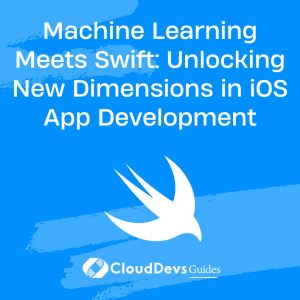Machine Learning Meets Swift: Unlocking New Dimensions in iOS App Development
Machine learning (ML) has grown exponentially over the past few years. As a testament to its power, more and more mobile applications are incorporating ML capabilities to improve user experiences, offer smart recommendations, and enable a variety of innovative features. If you’re developing for iOS, or looking to hire Swift developers with a deep understanding of ML, Swift is a clear choice for incorporating ML into your apps. In this post, we’ll explore some of the top ML libraries available for Swift and iOS, complete with examples.
Table of Contents
1. Core ML
What is Core ML?
Core ML is Apple’s dedicated machine learning framework for iOS, macOS, watchOS, and tvOS. It allows developers to integrate a wide range of ML models into their apps with minimal code.
Example:
To add an image classification feature using Core ML:
- First, obtain a Core ML model, which typically has a `.mlmodel` extension.
- Drag and drop the model into your Xcode project.
- Swift will automatically generate an interface for the model.
```swift
import CoreML
import Vision
let model = try? VNCoreMLModel(for: YourModelName().model)
let request = VNCoreMLRequest(model: model!) { (finishedReq, err) in
// Handle the results
}
let handler = VNImageRequestHandler(ciImage: image)
try? handler.perform([request])
```
2. TensorFlow Lite for iOS
What is TensorFlow Lite?
TensorFlow Lite is an open-source deep learning framework from Google. It’s a lightweight version of TensorFlow designed for mobile and embedded devices.
Example:
Using TensorFlow Lite to recognize handwritten digits:
- Convert your trained TensorFlow model to the TensorFlow Lite format (`.tflite`).
- Integrate the TensorFlow Lite iOS framework into your app.
- Use the framework to run inference.
```swift import TensorFlowLite let modelPath = Bundle.main.path(forResource: "your_model", ofType: "tflite") let interpreter = try Interpreter(modelPath: modelPath) try interpreter.allocateTensors() // Input data processing let inputTensor = try interpreter.input(at: 0) // ... [your preprocessing code here] // Run inference try interpreter.invoke() // Extract output let outputTensor = try interpreter.output(at: 0) // ... [your postprocessing code here] ```
3. Swift for TensorFlow
What is Swift for TensorFlow?
Swift for TensorFlow (S4TF) was a project from Google that aimed to bring TensorFlow’s capabilities directly into the Swift language. While its development has slowed, it offers unique features like first-class differentiable programming.
Example:
Training a simple linear regression model:
```swift
import TensorFlow
let x: Tensor<Float> = [1, 2, 3, 4]
let y: Tensor<Float> = [2, 4, 6, 8]
var w: Tensor<Float> = [1.0]
let learningRate: Float = 0.1
for _ in 0..<100 {
let hypothesis = x * w
let cost = (hypothesis - y).squared().mean()
let gradient = x * (hypothesis - y).mean()
w -= learningRate * gradient
print(cost)
}
```
4. Create ML
What is Create ML?
Create ML is a tool by Apple, mainly aimed at developers without deep ML expertise. It allows you to train and deploy models directly from a graphical interface or through Swift code in a macOS app.
Example:
Training an image classifier:
- Prepare your data into labeled folders.
- Drag and drop your data into Create ML.
- Choose the “Image Classifier” template.
- Click “Train”.
- Once trained, you can export the model and use it with Core ML.
5. Benefits of Using Swift for ML on iOS
– Performance: Leveraging the hardware acceleration available on Apple devices, ML libraries optimized for Swift can provide efficient real-time performance.
– Privacy: Processing data on-device allows for better user privacy as the data doesn’t need to be sent to a server.
– Integration: Swift libraries are often integrated with other Apple frameworks, ensuring seamless and consistent development experiences.
Wrapping Up
Machine Learning is no longer reserved for cloud servers and high-performance computers. Modern mobile devices, especially Apple’s range of products, have powerful capabilities that developers can harness to provide enriched app experiences. Whether you are a machine learning expert or a general iOS developer looking to dabble in ML, Swift has got you covered with a range of libraries and tools tailored for all levels of expertise.
Considering the growing trend, many businesses are eager to hire Swift developers who can seamlessly integrate machine learning into their apps. Embrace the future of mobile app development by incorporating machine learning into your next iOS project. It’s exciting, powerful, and, with Swift, easier than you might think.
Table of Contents









